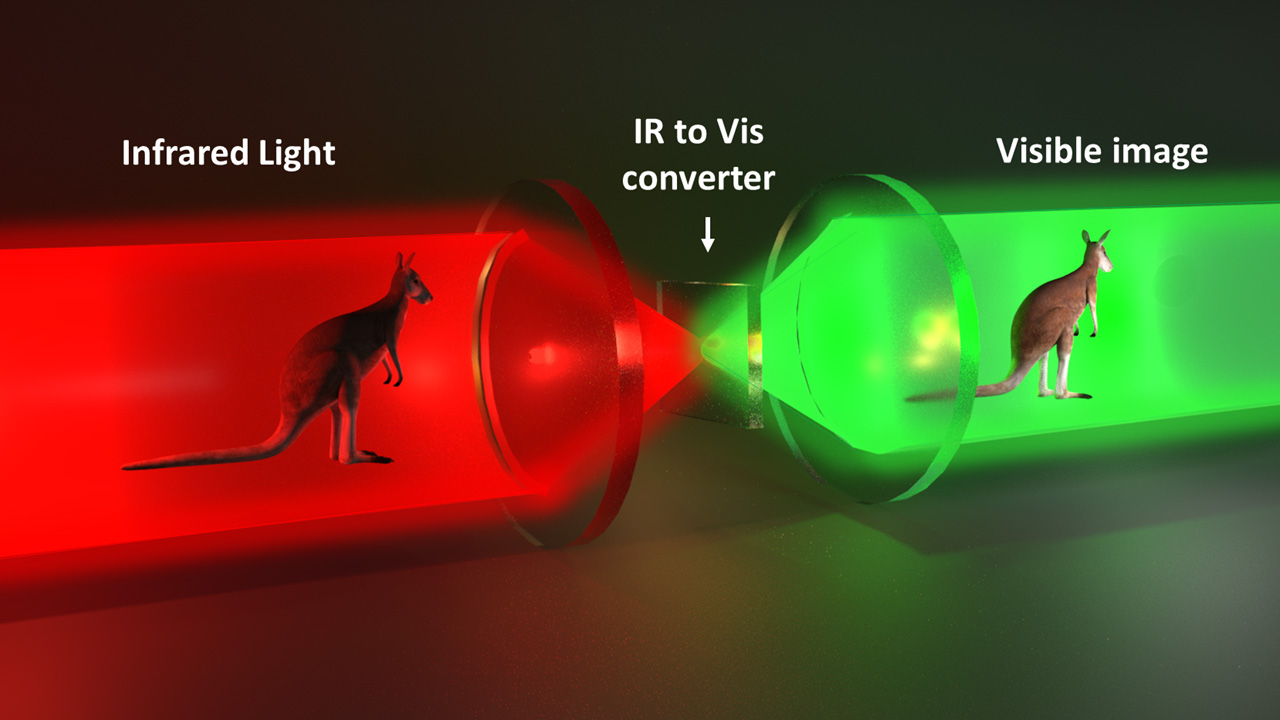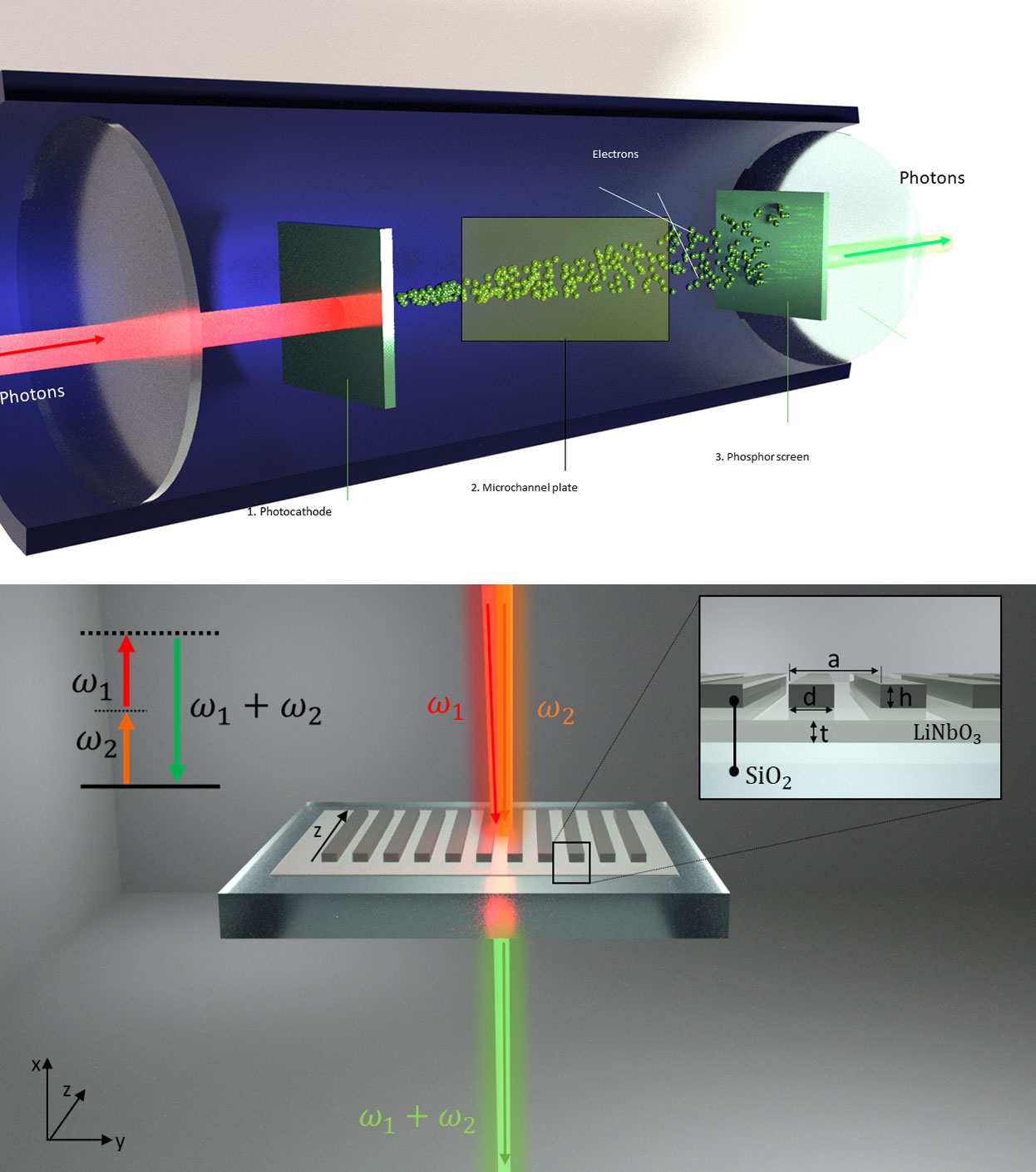In a system demonstrated by researchers at the Australian National University, Canberra, a thin lithium-niobate metasurface upconverts an image in infrared light to the visible range. [Image: L. Valencia Molina / Australian National University]
In films and video games, plot points sometimes hinge on infrared imaging: The soldier or spy straps on a pair of night-vision goggles, and the skulking enemy is revealed amid the darkness. In reality, though, such devices tend to be bulky and awkward for field use—more Rube Goldberg than James Bond.
Now, a research team in Australia hopes to slim down night-vision technology considerably. The team’s secret weapon is an ultracompact, high-Q lithium niobate (LN) metasurface that can handle up-conversion of infrared signals to the visible, where they can be easily processed by conventional CMOS image sensors (Adv. Mater., doi: 10.1002/adma.202402777).
The researchers believe that the metasurface—described in a press release as being “thinner than a piece of cling wrap”—could eventually bring more compact, room-temperature night-vision devices and sensors, potentially opening the technology to much broader adoption.
Special needs
The bulk and inconvenience of much traditional night-vision technology, based on narrow-bandgap semiconductors, stems partly from basic optical design, and partly from the special need to get around thermal noise.
In a traditional setup, infrared photons are focused onto a photocathode that converts them to electrons; these are then amplified by a microchannel plate and re-converted to visible-wavelength photons to create a “thermal” image bright enough to be seen by the human eye. Such a system requires bulky optics, and commonly also needs cryogenic cooling to keep thermal noise from being amplified along with the desired infrared signal.
Top: A traditional night-vision system takes an infrared signal, converts it to an electronic signal that is amplified, and then re-converts it to visible light—a setup that adds bulk and requires cryo-cooling to avoid amplifying thermal noise. Bottom: The Australian team's approach uses a lithium niobate metasurface to handle the up-conversion from the infrared signal to the visible, by-passing the bulk lens and intermediate electronics. [Image: L. Valencia Molina / Australian National University]
What’s more, as a practical matter, this conventional night-vision configuration often prevents visible light from being captured through the same lens as the infrared light. That can foreclose the opportunity for interesting applications that enable viewing of the visible and infrared signals at the same time.
Metasurfaces to the rescue?
One potential route to thinner, room-temperature devices is to outsource the up-conversion process to a resonant dielectric metasurface—an ultrathin surface decorated with nanoscale “meta-atoms” specifically engineered for the purpose at hand. In such a scheme, the infrared light is imaged onto a thin surface that has been engineered to convert the infrared signal to shorter-wavelength visible light (via a nonlinear process such as sum-frequency generation, or SFG). The up-converted image can then be captured by a conventional digital camera sensor.
As an all-optical approach, this metasurface-enabled scheme avoids many of the pitfalls of traditional night-vision equipment, including bulky lenses and electronics and the need for cryogenic cooling. It could even, in principle, allow the processing of infrared and visible light at the same time.
As so often is the case, however, the devil is in the details. One issue is that it’s been difficult to create high-quality-factor (high-Q) metasurfaces that can enable adequate conversion efficiency. Further, those high-Q surfaces that have been designed have suffered from low operational bandwidth and angular dispersion, limiting image quality and resolution.
An LN metasurface
The team behind the new work—led by researchers from the Australian National University, Canberra, and also including scientists from Friedrich Schiller University Jena, Germany—think they’ve found a way around these problems. The group’s approach? Combining a new high-Q metasurface with a clever adjustment of the imaging geometry.
As a first step, the team, whose previous work had focused on gallium arsenide metasurfaces, turned to a different material, lithium niobate, for their latest designs. Previous work by researchers in China had shown an “etchless” design using patterned SiO2 gratings atop an un-etched thin LN film can improve nonlinear conversion efficiencies. As an added bonus, LN is transparent to both visible and infrared wavelengths, opening the prospect of simultaneous infrared and visible imaging through the same device.
The Australian group’s approach combined a new high-Q metasurface with a clever adjustment of the imaging geometry.
The team created such metasurfaces by depositing a thin film of LN on a quartz substrate, and topping things off with a 200-nm-thin layer of SiO2. The quartz layer was then chemically dry-etched to create the metasurface detail atop the LN thin film. The team fashioned metasurfaces with a variety of Q factors using this method.
From up-conversion to imaging
With the metasurfaces in hand, the team used a white-light source and a tunable laser to characterize the surfaces’ transmission characteristics in various spectral regions. The researchers then tested the surfaces’ nonlinear up-conversion prowess by illuminating them with a Ti:sapphire femtosecond laser that produced pulses from 850 to 1550 nm in wavelength. The team confirmed strong resonances, nonlinear enhancements and conversion to visible light by the etchless LN metasurfaces. For one metasurface in particular (Q=40), the researchers measured what they believe are record values for SFG efficiency.
Having established the surfaces’ up-conversion efficiency, the team next turned to their imaging performance. Here, as with other high-Q metasurfaces, the ones engineered by the researchers suffered from high angular dispersion, in principle leading to potentially poor spatial resolution.
This is where the imaging geometry came in. The team found it was able to get around the resolution disadvantage by placing the up-conversion metasurface not at the imaging plane, as in previous studies, but in the Fourier plane of the target. This enabled the up-conversion of all spatial frequencies equally, avoiding the loss of resolution. The Fourier image was then re-converted (via an array of plano-convex lenses) back to the image plane and onto a CMOS sensor.
Next step: Expanding the wavelength range
The team says its setup achieved “a record high up-conversion imaging efficiency with high spatial resolution.”
By leveraging this combination of a high-Q metasurface and their Fourier-space up-conversion geometry, the researchers were able to demonstrate the generation of green visible-light images of a variety of objects illuminated only by infrared light. The team says its setup achieved “a record high up-conversion imaging efficiency with high spatial resolution.”
In a press release accompanying the study, coauthor Rocio Camacho Morales called it “the first demonstration of high resolution up-conversion imaging from 1550 nm infrared to visible 550 nm light in a non-local metasurface.” Camacho Morales noted that the team tested out the system at 1550 nm because of that wavelength’s importance in the telecom sector. The team’s future work, she said, will focus in part on expanding the range of wavelengths accessible by the system—something that would seem crucial for night-vision applications.
That said, the authors conclude that the study results “could find important applications in future compact night-vision instruments, sensor devices, and multi-color imaging at room temperature.”



